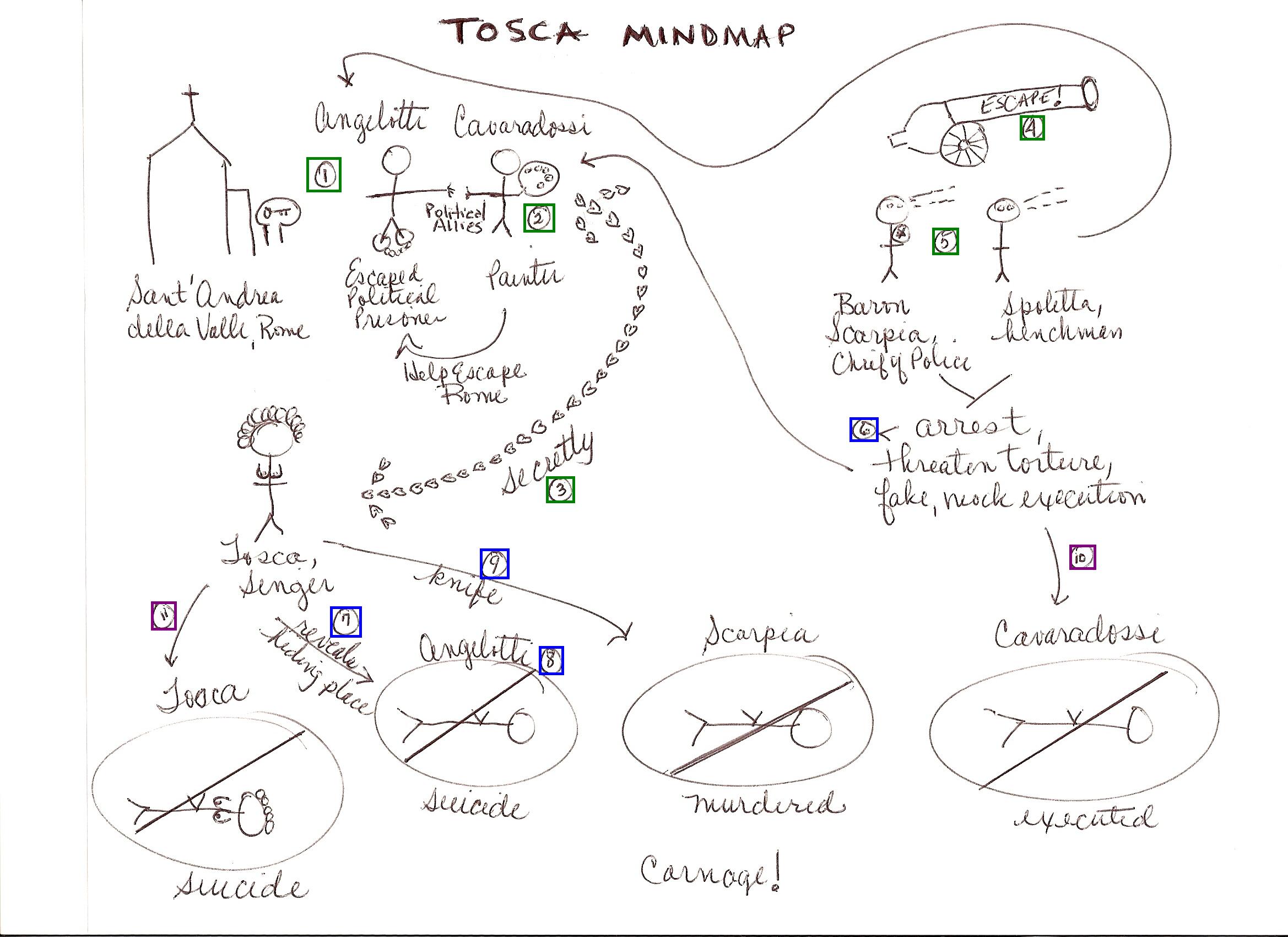I used to attend the opera with my friend Mary Rossini, which started off when she wanted a date but was hard-pressed to find any straight men who enjoyed the opera.
Before we went, I usually created a mind map of the synopsis, which we liked to hold in our laps and do “air checks” when something in the mind map happened on the stage. Sometimes the people around us didn’t appreciate our irreverence.
We also both enjoyed looking for typos—and gasping when we saw one—in the supertitles when the operas aren’t in English, which of course, is most of them. (Although, there are some.)
Here are 4 operas I’ve done mind maps for, and which got progressively more elaborate:
The Merry Widow
Hanna Glawari is a vastly wealthy young widow from the small and poverty-stricken Balkan province of Pontevedro. Ambassador Baron Zeta is anxious that when Hanna re-marries, it is to a Pontevedrian and not a Frenchman, to keep her money in the country and save them all from ruin. The obvious choice is Count Danilo, but there is a problem. They are exes, and he is too proud to marry her for her money.
The Baron’s wife, Valencienne, is having an affair (and with Frenchman Camille, Count de Rosillon, no less!) and Hanna steps in to save the married lady’s reputation. When Hanna claims that it is she who intends to marry Camille, the Pontevedrians despair, but Danilo is forced to recognize the extent of his feelings for her. How will it end? Will they? Won’t they? (Synopsis compliments of The Merry Widow in a nutshell.)

Tosca
The action takes place over fewer than 24 hours. The plot centers around 3 main characters—Rome’s diva Floria Tosca, her lover Mario Cavaradossi (a painter and republican) and the corrupt Chief of Police, Baron Scarpia. Scarpia has long lusted after Tosca, and when he suspects Cavaradossi of assisting an escaped political prisoner, seizes the opportunity to kill two birds with one stone. He will manipulate Tosca into revealing the prisoner’s hiding place and Cavaradossi’s involvement, and have her for himself.
When Cavaradossi is captured, Scarpia offers Tosca a horrific bargain—she must give herself to Scarpia, or her lover is killed… what will she choose, and who will survive? (Synopsis compliments of Tosca in a nutshell.)

Rigoletto
The opera is set in the world of the Duke of Mantua – a morally corrupt, womanizing ruler. We begin at the Duke’s party, during which he mentions having his eye on a mystery beauty. His jester Rigoletto – who is despised for being different – mocks all the guests, including a statesman, Monterone, who is furious that his daughter has been molested by the Duke. In retaliation, Monterone places a curse on Rigoletto.
Back at Rigoletto’s safehouse, we meet his beloved daughter Gilda, whom he fiercely protects. Even so, she has managed to fall in love with a mystery man she has seen (who turns out, of course, to be the Duke). Later that night, Gilda is abducted and delivered, much to the Duke’s delight, to his bedroom!
On discovering that the Duke has got his hands on Gilda, Rigoletto is distraught, and approaches the assassin Sparafucile to help him wreak his revenge. However, the plan goes terribly wrong, and we see Monterone’s curse come to pass in a devastating way… (Synopsis compliments of Rigoletto in a nutshell.)

The Barber of Seville
Bribery, deception and disguise. Figaro needs all his wiles to help the Count out-wit Dr Bartolo and ensure true love wins the day.
[It] is a feast of frivolous fun. Enjoy Figaro’s mischievous escapades as he assists Count Almaviva in prizing the beautiful Rosina away from her lecherous guardian, Dr Bartolo. (Synopsis compliments of eno.org.)
